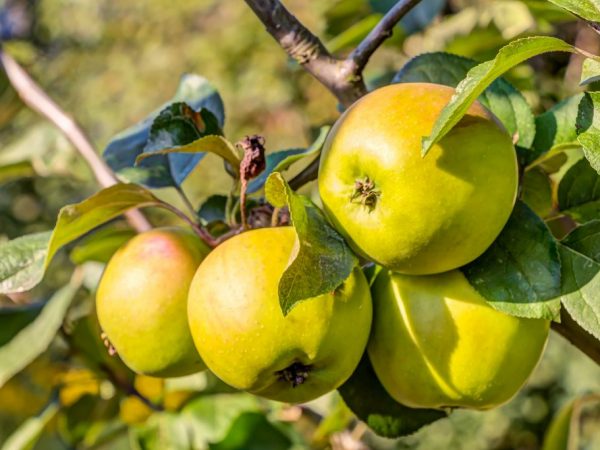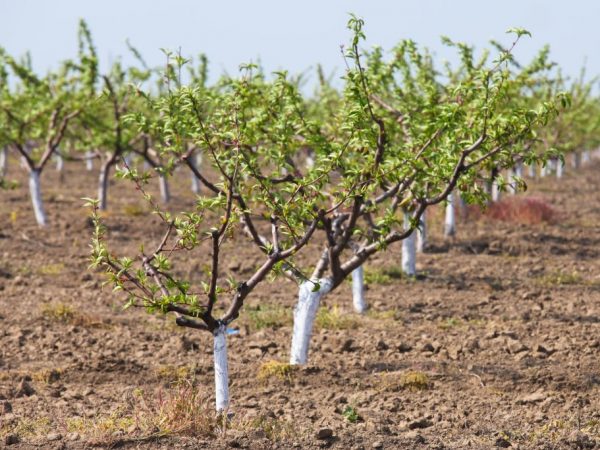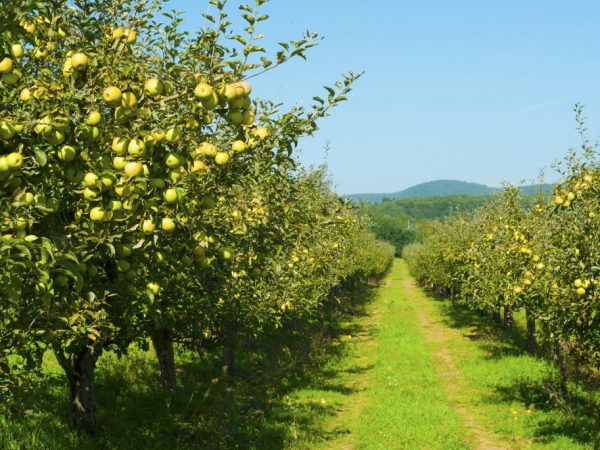Features of the apple tree Bratchud
The apple tree Bratchud (or Brother of the Wonderful) was bred at the South Ural Institute of Fruit and Vegetable Growing in Chelyabinsk. According to the official description, this variety is a dwarf.
- Characteristic
- Description of the tree and fruit
- Tasting assessment
- Yield
- Pollinators
- Winter hardiness
- Disease resistance
- Life span
- How to choose seedlings
- Description of the planting process
- Timing
- Technology
- Care
- Watering
- Loosening
- Top dressing
- Pruning
- Disease prevention
- Ripening and fruiting
- Harvesting and storage
- Subspecies
- Growing in regions
- Gardeners reviews
- Benefits
- disadvantages

Features of the apple tree Bratchud
Characteristic
Vydubetskaya Plakuchaya and Zimnyaya Uralskaya helped to bring out the apple variety Brother Chudny. The first samples were planted in Siberia and the Urals.
Then it turned out that this is a good option for growing in other regions of Russia, incl. in Altai and northwest.
Description of the tree and fruit
The apple tree has a crown with a diameter of 2.5 to 3 m.On clone rootstocks, the height of the tree reaches 2 m.Using seeds, you can grow it up to 2.7 m.
On the stems and trunk, the bark is brown, depending on the growth conditions, it can be light or dark. Bears fruit evenly on all shoots.
Young branches are green-brown and grow rapidly. There is pubescence on the top of large rounded leaves. On their edges, you can see the jaggedness.
According to the description, apples of medium size are slightly elongated. The fruits may be ribbed. Their main difference is the side seam. The surface of the apple is glossy, smooth, without bloom. The peel is thin, and the color of the fruit is green-yellow.
Ripe fruits have white flesh. Its composition has components useful for the body - sugars, acids, pectins, etc.
One apple weighs from 150 to 250 g. Up to 120-130 kg of fruit are harvested from the tree.
Tasting assessment
Apples are rated at 4.7 points. They have a yellowish-green color, you can also see a pink blush. Unripe fruits have a greenish pulp. Fruit with a white center should be eaten.
To the taste, the fruits are very juicy and sweet, have a characteristic sourness, which gives an unusual taste.
Yield
The variety bears fruit regularly, starting from the 4th year. The crop is harvested every season, until the end of the life of the tree, it grows for about 15-20 years.
The fruits ripen at the end of September. During this period, the fruits are removed from the tree and transported to the place where they plan to store them.
Pollinators
Cross-pollination is necessary for the fruit to set. Sokolovskaya and Chudnaya apple trees, as well as Snowdrop, are suitable.
Winter hardiness
According to the description, the Bratchud variety has high frost resistance, even in severe winters the apple tree freezes over.
At -40 ° and below, additional care of the crop is necessary - otherwise, its roots may suffer.
Disease resistance

Processing will help protect the apple tree from pests
The main danger is scab. Her spores are carried by gusts of wind. The disease is noticed by carefully examining the leaves. It is expressed in light green spots of small size on the back.
Then she moves on to fruits. They crack at first, and if the disease gets inside, you can lose the crop.
Scab is most dangerous in wet weather. For prophylaxis in the spring, apple trees are treated with 3% Bordeaux liquid. The same procedure is repeated at the stage of blooming buds. After harvesting, the crop is sprayed with urea.
Bratchud is also treated against pests. These are moths, sapwoods, silkworms, hawthorns and moths.
Life span
The apple tree has a short lifespan. After 15-20 years, fruiting ends. When this happens, it is harvested and replaced with new seedlings. After 4 years, a new crop is harvested.
How to choose seedlings
Gardeners are advised to consider several buying rules:
- it is better to buy in fruit nurseries (they offer certificates for the culture, all information about the seedling is indicated in it);
- age of about 2 years provides good survival;
- the roots must be firm and moist, without damage;
- the lobe is chosen well developed;
- shoots of the 2nd order should have smooth bark and medium-sized buds;
- examine the plant for signs of damage by insects and places affected by diseases.
If the purchase is made at a market or fair, the tree is inspected between the stem and the neck for the presence of a knee-shaped protrusion. A 2-year-old seedling usually has 4 well-developed branches with large buds. A healthy apple tree should have many small, elastic roots.
Description of the planting process
Before planting Bratchud, you need to determine the place of cultivation. The yield depends on this. An ideal site is one that is elevated in the sun or a little shade and protected from the wind.
A good option for planting is a substrate, although in sandy and clayey soil the tree also grows well and bears a lot of fruits.
Preparation consists of two stages: processing the site and inspecting the seedling. If you plan to plant an apple tree in the spring, you need to fertilize and dig up the land in the fall. Leaves are removed from the site, the soil is dug and fertilizers are added to it.
A month before planting, a hole is dug 1.5 m deep and in size. Humus or peat is laid out at the bottom. So that the trees do not interfere with each other, there must be a distance of at least 3 m on each side.
The preparation of future apple trees is carried out a day before planting: they are carefully examined to determine the viability of Bratchud. If the roots are dry, they are placed in water for a day. The roots are cut a little, which forms the lower stem.
Timing

It is better to plant seedlings in spring.
The best time to plant a bonsai is spring.
But you can plant it in the fall. The main thing is to have time to do this in October so that the apple tree takes root before winter.
Technology
In the fall, when the tree goes dormant, you can start organizing the planting site and place a seedling on it. A 20-centimeter layer of earth from the pit is thrown back to prepare a substrate from it. To do this, the soil is combined with 2 buckets of humus, ash and phosphate - they are taken 600 g each. After mixing, the mixture is poured into a pit into which a stake is driven in the center. This will create a hill - and there will be a seedling on it. The roots are straightened and covered with the remaining substrate.
The last layer is soil without any fertilizers. At the end of the work, check that the vaccination site is 3-4 cm above the ground.
After planting, the soil near the plants is tamped. Having stepped back 50 cm from the trunk, a 15-centimeter roller is made from the ground. Pour 25 liters near the trees. When it is absorbed, the area is covered with humus no more than 3 cm high. But it shouldn't touch the trunks. After that, the seedling is tied to the stake.
If the planting takes place in the spring, all stages are performed in the same way. If the pit was prepared in the fall, no fertilizer is used.
Care
Watering
Before the beginning of fruiting, the tree is periodically watered, up to 5 times a year. 5 buckets of water are poured in at a time. When it is absorbed, the earth in a circle near the trunk is fluffed so that it does not harden.
Loosening
In the course of loosening, weeds are removed from the soil that interfere with the growth of the apple tree. In hot weather and in winter, the circles are mulched to prevent moisture evaporation and protect the roots from frost.
Sawdust, dry grass, peat are suitable for this.
Top dressing
To achieve the maximum yield, periodic feeding is also necessary (2-3 times a year). To do this, take an infusion of mullein, mixed in equal proportions with water, or chicken droppings. It is diluted with water 1:20.
Pigeon droppings, bone and fish meal, whey, straw, peeling potatoes and bananas, onion husks, egg shells and nettles are also used as top dressing.
3 years after the start of growth, mineral fertilizers are added under the trees.
Pruning
Pruned for sanitary purposes, to distribute fruit and remove weak branches. They remove damaged and weak shoots without leaving voids.
Sometimes the buds are cut off at the top - the middle ones will develop better. This procedure is carried out twice a year - at the beginning of the season and in the fall. They constantly control growth so that the strong branches are lower than the weak ones.
Disease prevention

The variety does not tolerate cold
The roots of the culture are close to the soil - in extreme cold, apple trees can freeze underneath, therefore, to protect Brother the Wonderful, they shelter before the winter frosts.
In November, the trunk circle is watered and covered with compost. If the place is with a high occurrence of water, watering is not carried out.
To protect the culture from rodents, you can wrap the trunks with roofing material, spruce branches, roofing paper. Plastic trellis enclosing trees are also suitable for this.
Ripening and fruiting
Apples can be tasted after 3-4 years. They ripen at the end of September, but they are harvested in October - shedding is characteristic of the variety.
Fruiting is characteristic of all types of wood and old growths, and even in unfavorable weather.
Harvesting and storage
Apples are stored at -3-7 ° for about 5 months. To extend this period, the fruits are sent to the refrigerator or cellar.
Fruit lends itself well to transportation. Their use is universal: apples are eaten fresh and I make various preparations. Delicious wines, compotes, jams, juices are obtained from Bratchud.
Subspecies
This dwarf variety is used in breeding. With its help, stunted species are displayed:
- creeping - a tree with a flat crown, 2 m long. Juicy fruits reach a weight of 120-150 g. Differs in good yield and fruit quality;
- naturally low - an apple tree with a low crown, 2 m long. Fruits reach a weight of 160-180 g. Differs in excellent resistance to wind and frost;
- dwarf - has a restrained growth (up to 1.5 m) and a small crown;
- super dwarf - does not grow above 1 m. This species will save space on the site. Among its drawbacks is poor crop growth and no more than 13 years of life.
Growing in regions
Winter Bratchud is suitable for all of Russia, but there are special care features for different areas. In the Moscow region, during droughts, trees are watered 3 times a month, 30 liters of water each. In the Urals, they are looking for areas where there were no fruit crops before. In the fall, the variety is fed with complex fertilizers, and in the spring with nitrogen. In Siberia, the trunk circle is covered with the thickest layer of compote before winter. In the middle lane, seedlings are grown in the southern parts of the garden.
Gardeners reviews
Apple tree The brother of the miraculous has tasty fruits that can be stored for a long time. Gardeners note that, subject to the rules for planting and care, they delight with a good annual harvest.
They also advise taking into account the disadvantages of the variety and not forgetting to inspect for damage and disease, cover before cold weather and make good supports to avoid falls.
Benefits
- early maturity - bears fruit from the 4th year. If you plant a 2-year-old seedling, you can harvest the first crop after 2 years;
- good productivity - one tree brings up to 120 kg of apples;
- excellent frost resistance;
- small size - on such a tree it is easier to collect fruits and easier to care for the crown;
- compacted planting - dwarf apple trees need a smaller area: Bratchud is enough for 8-9 m², and ordinary ones need up to 30 m²;
- root system close to the ground - does not suffer from water, like other varieties that rot because of them.
disadvantages
- short fruiting period: lives no more than 20 years;
- unstable roots - when overloaded with fruits, it can fall: you need to take care of good support;
- the possibility of scab damage;
- the need for winter shelter due to the close occurrence of the root;
- dependence on temperature - drought and humidity can impair the taste of the fruit.

